Numerical Investigation of Top Coal Drawing Evolution in Longwall Top Coal Caving by the Coupled Finite Difference Method-Discrete Element Method
Abstract
:1. Introduction
2. Numerical Method
2.1. Engineering Background
2.1.1. General Situation
2.1.2. Top Coal Block Size Distribution
2.2. Numerical Model
2.3. Simulation Process
3. Simulation Results
3.1. Mining Preparation and Drawing Preparation Stages
3.2. Top Coal Drawing Stage
3.2.1. Evolution of DB
3.2.2. Evolution of LB
3.2.3. Evolution of TCB
- ①
- There is a definite horizontal asymptote and the curve is asymmetrical. Horizontally, the curve will approach the original TCB, that is, the original TCB is its definite asymptote. Vertically, the formation of the curve is affected by gravity and the drawing opening, the boundary condition differs from that applied to the horizontal face, indicating that it is asymmetrical.
- ②
- The curve approaches the horizontal asymptote at a slower rate. The curve above the hydraulic support shield beam, tail beam, and the rear scraper conveyor increases slightly in the vertical direction, that is, the rate at which the TCB approaches the horizontal asymptote is low within this range, especially during the first to the seventh caving rounds.
- ③
- The curve deflects toward the working face above the rear scraper conveyor. After each caving event, the TCB deflects toward the working face advance direction at the rear scraper conveyor, as shown by the purple dotted arrowhead in Figure 11.
4. Discussion
- (1)
- Numerical model
- (2)
- Limitations and weaknesses of the method
- (3)
- Advance abutment pressure
- (4)
- Transitional Process
5. Conclusions
- The evolution of DB parameters such as ADB, WDB, HDB, LDB, and θDB from first drawing round to common drawing stage showed a trend whereby they first decreased, then increased, decreased again, and finally stabilised. Specifically, the parameters were observed to reach their respective maxima after the first drawing round and then gradually decrease, only to increase again after the fourth drawing round, and then stabilise. After stabilisation, ADB was around 6 t, WDB was 2.7 m, HDB was 4.0 m, LDB was around 4.0 m, and θDB was around 10°. In the numerical simulation, the fourth drawing round was the key turning point in the DB evolution.
- The evolution of LB parameters such as WLB, Sw, and Sp and increments thereof was analysed from the first drawing round to the common drawing round. △Sw and △Sp were close to 0 m in the common caving stage, while △WLB was close to the caving interval (0.865 m) in this stage. In the numerical simulation, the fourth drawing round was the key turning point in the LB evolution.
- The TCBs formed in each drawing round were fitted. From the perspective of the height and radius of curvature stagnation point, the evolution of the TCB was analysed. The process was divided into three stages in the numerical simulation: the first (first to third drawing rounds) was the initial mining influence stage, the second (fourth to ninth drawing rounds) was the transitional caving stage, and the third (after tenth drawing round) represented the common drawing stage.
- As some hypotheses were made in relation to the boundary conditions, the model, and numerical simulation process, its result did not directly correspond to actual engineering conditions, but can provide reference to some extent. It is believed in this present study that the above-mentioned transitional process must exist during mining operations, but due to the complexity of the in-situ conditions, the key transition point cannot be a certain drawing round and there may be multiple key transition points.
- We believe that the research results of this paper are applicable to other coal mines in the world with occurrence conditions similar to those of Wangjialing coal mine with the same mining method. In the process of numerical modeling, all parameters are obtained according to the actual site conditions. Under different engineering backgrounds, the obtained parameters are different. Therefore, this numerical method has high flexibility, which is suitable for the simulation of top coal movement in any top coal caving mining.
Author Contributions
Funding
Conflicts of Interest
List of Symbols and Abbreviations
| LTCC | Longwall top coal caving |
| FDM | Finite difference method |
| DEM | Discrete element method |
| DB | Drawing body |
| LB | Loose body |
| TCB | Top coal boundary |
| BBR | Body-Boundary-Ratio |
| ADB | Drawing amount |
| WDB | Horizontal width of DB |
| HDB | Vertical height of DB |
| LDB | Long-axis length of the DB profile ellipsoid |
| θDB | Included angle of the DB profile ellipsoid |
| Sw | Horizontal distances between the edge of LB and coal wall |
| Sp | Horizontal distances between the edge of LB and coal pillar |
| WLB | Total width of LB |
| ΔSw | Increment of Sw |
| ΔSp | Increment of Sp |
| ΔWLB | Increment of WLB |
References
- Tu, S.-H.; Yuan, Y.; Yang, Z.; Ma, X.-T.; Wu, Q. Research situation and prospect of fully mechanized mining technology in thick coal seams in China. In Proceedings of the International Conference on Mining Science & Technology; Ge, S., Liu, J., Guo, C., Eds.; Elsevier: Amsterdam, The Netherlands, 2009; Volume 1, pp. 35–40. [Google Scholar]
- Singh, G.S.P.; Singh, U.K. Numerical Modeling Study of the Effect of Some Critical Parameters on Caving Behavior of Strata and Support Performance in a Longwall Working. Rock Mech. Rock Eng. 2010, 43, 475–489. [Google Scholar] [CrossRef]
- Bai, Q.-S.; Tu, S.-H.; Wang, F.-T.; Zhang, X.-G.; Tu, H.-S.; Yuan, Y. Observation and Numerical Analysis of the Scope of Fractured Zones Around Gateroads Under Longwall Influence. Rock Mech. Rock Eng. 2014, 47, 1939–1950. [Google Scholar] [CrossRef]
- Le, T.D.; Bui, X.N. Effect of Key Parameters on Top Coal First Caving and Roof First Weighting in Longwall Top Coal Caving: A Case Study. Int. J. Geomech. 2020, 20, 5. [Google Scholar] [CrossRef]
- Bai, Q.; Tu, S. A General Review on Longwall Mining-Induced Fractures in Near-Face Regions. Geofluids 2019, 2019, 3089292. [Google Scholar] [CrossRef] [Green Version]
- Oge, I.F. Prediction of Top Coal Cavability Character of a Deep Coal Mine by Empirical and Numerical Methods. J. Min. Sci. 2018, 54, 793–803. [Google Scholar] [CrossRef]
- Bian, Z.; Miao, X.; Lei, S.; Chen, S.-E.; Wang, W.; Struthers, S. The Challenges of Reusing Mining and Mineral-Processing Wastes. Science 2012, 337, 702–703. [Google Scholar] [CrossRef]
- Wang, J.; Wei, W.; Zhang, J.; Mishra, B.; Li, A. Numerical investigation on the caving mechanism with different standard deviations of top coal block size in LTCC. Int. J. Min. Sci. Technol. 2020, 30, 583–591. [Google Scholar] [CrossRef]
- Wang, J.; Wang, Z.; Li, Y. Longwall Top Coal Caving Mechanisms in the Fractured Thick Coal Seam. Int. J. Geomech. 2020, 20, 06020017. [Google Scholar] [CrossRef]
- Yang, S.; Wei, W.; Zhang, J. Top Coal Movement Law of Dynamic Group Caving Method in LTCC with an Inclined Seam. Min. Metall. Explor. 2020, 37, 1545–1555. [Google Scholar]
- Song, Z.; Konietzky, H. A particle-based numerical investigation on longwall top coal caving mining. Arab. J. Geosci. 2019, 12, 556. [Google Scholar] [CrossRef]
- Wang, J.; Wei, W.; Zhang, J. Effect of the size distribution of granular top coal on the drawing mechanism in LTCC. Granul. Matter 2019, 21, 70. [Google Scholar] [CrossRef]
- Wang, J.; Wei, W.; Zhang, J.; Mishra, B. Laboratory and field validation of a LTCC recovery prediction model using relative size of the top coal blocks. Bull. Eng. Geol. Environ. 2020. [Google Scholar] [CrossRef]
- Liang, Y.; Li, L.; Li, X.; Wang, K.; Chen, J.; Sun, Z.; Yang, X. Study on Roof-Coal Caving Characteristics with Complicated Structure by Fully Mechanized Caving Mining. Shock Vib. 2019, 2019, 6519213. [Google Scholar] [CrossRef]
- Tien Dung, L.; Oh, J.; Hebblewhite, B.; Zhang, C.; Mitra, R. A discontinuum modelling approach for investigation of Longwall Top Coal Caving mechanisms. Int. J. Rock Mech. Min. Sci. 2018, 106, 84–95. [Google Scholar]
- Hu, S.; Ma, L.; Guo, J.; Yang, P. Support-surrounding rock relationship and top-coal movement laws in large dip angle fully-mechanized caving face. Int. J. Min. Sci. Technol. 2018, 28, 533–539. [Google Scholar]
- Zhang, J.-W.; Wang, J.-C.; Wei, W.-J.; Chen, Y.; Song, Z.-Y. Experimental and numerical investigation on coal drawing from thick steep seam with longwall top coal caving mining. Arab. J. Geosci. 2018, 11, 96. [Google Scholar] [CrossRef]
- Klishin, S.V.; Klishin, V.I.; Opruk, G.Y. Discrete element modeling of gravity flow of broken rocks in the technology of longwall top coal caving. In International Scientific Conference Knowledge-Based Technologies in Development and Utilization of Mineral Resources; Fryanov, V., Ed.; IOP Publishing Ltd.: Novokuznetsk, Russia, 2018; Volume 206. [Google Scholar]
- Klishin, V.I.; Fryanov, V.N.; Pavlova, L.D.; Opruk, G.Y. Modeling Top Coal Disintegration in Thick Seams in Longwall Top Coal Caving. J. Min. Sci. 2019, 55, 247–256. [Google Scholar] [CrossRef]
- Wang, J.; Zhang, J.; Li, Z. A new research system for caving mechanism analysis and its application to sublevel top-coal caving mining. Int. J. Rock Mech. Min. Sci. 2016, 88, 273–285. [Google Scholar] [CrossRef]
- Yu, B.; Zhang, R.; Gao, M.-Z.; Li, G.; Zhang, Z.-T.; Liu, Q.-Y. Numerical Approach to the Top Coal Caving Process under Different Coal Seam Thicknesses. Therm. Sci. 2015, 19, 1423–1428. [Google Scholar] [CrossRef]
- Zhu, D.; Chen, Z.; Du, W.; Zhang, L.; Zhou, Z. Caving mechanisms of loose top-coal in longwall top-coal caving mining based on stochastic medium theory. Arab. J. Geosci. 2018, 11, 621. [Google Scholar] [CrossRef]
- Castro, R.; Gomez, R.; Hekmat, A. Experimental quantification of hang-up for block caving applications. Int. J. Rock Mech. Min. Sci. 2016, 85, 1–9. [Google Scholar] [CrossRef]
- Castro, R.L.; Fuenzalida, M.A.; Lund, F. Experimental study of gravity flow under confined conditions. Int. J. Rock Mech. Min. Sci. 2014, 67, 164–169. [Google Scholar] [CrossRef]
- Yang, S.; Zhang, J.; Chen, Y.; Song, Z. Effect of upward angle on the drawing mechanism in longwall top-coal caving mining. Int. J. Rock Mech. Min. Sci. 2016, 85, 92–101. [Google Scholar] [CrossRef]
- Chi, M.; Zhang, D.; Fan, G.; Zhang, W.; Liu, H. Prediction of top-coal caving and drawing characteristics by the analytic hierarchy process-fuzzy discrimination method in extra-thick coal seams. J. Intell. Fuzzy Syst. 2017, 33, 2533–2545. [Google Scholar] [CrossRef]
- Zhang, Q.; Yuan, R.; Wang, S.; Li, D.; Li, H.; Zhang, X. Optimizing Simulation and Analysis of Automated Top-Coal Drawing Technique in Extra-Thick Coal Seams. Energies 2020, 13, 232. [Google Scholar] [CrossRef] [Green Version]
- Herezy, Ł.; Janik, D.; Skrzypkowski, K. Powered Roof Support–Rock Strata Interactions on the Example of an Automated Coal Plough System. Studia Geotech. Et Mech. 2018, 40, 46–55. [Google Scholar] [CrossRef] [Green Version]
- Krzysztof, S.; Waldemar, K.; Nguyen, D.T. Choice of powered roof support FAZOS-15/31-POz for Vang Danh hard coal mine. J. Pol. Miner. Eng. Soc. 2019, 21, 175–182. [Google Scholar]
- Huo, Y.; Song, X.; Sun, Z.; Wang, Z.; Li, H. Evolution of mining-induced stress in fully mechanized top-coal caving under high horizontal stress. Energy Sci. Eng. 2020, 8, 2203–2215. [Google Scholar] [CrossRef]
- Huo, Y.; Song, X.; Zhu, D. Numerical Investigation of Top-Coal Migration in the First Coal-Drawing Process by an FDM-DEM Coupling Method. Energies 2020, 13, 5493. [Google Scholar] [CrossRef]
- Zhu, D.; Song, X.; Li, H.; Liu, Z.; Wang, C.; Huo, Y. Cooperative load-bearing characteristics of a pillar group and a gob pile in partially caved areas at shallow depth. Energy Sci. Eng. 2020, 8, 89–103. [Google Scholar] [CrossRef] [Green Version]
- Zhu, D.; Wu, Y.; Liu, Z.; Dong, X.; Yu, J. Failure mechanism and safety control strategy for laminated roof of wide-span roadway. Eng. Fail. Anal. 2020, 111, 104489. [Google Scholar] [CrossRef]
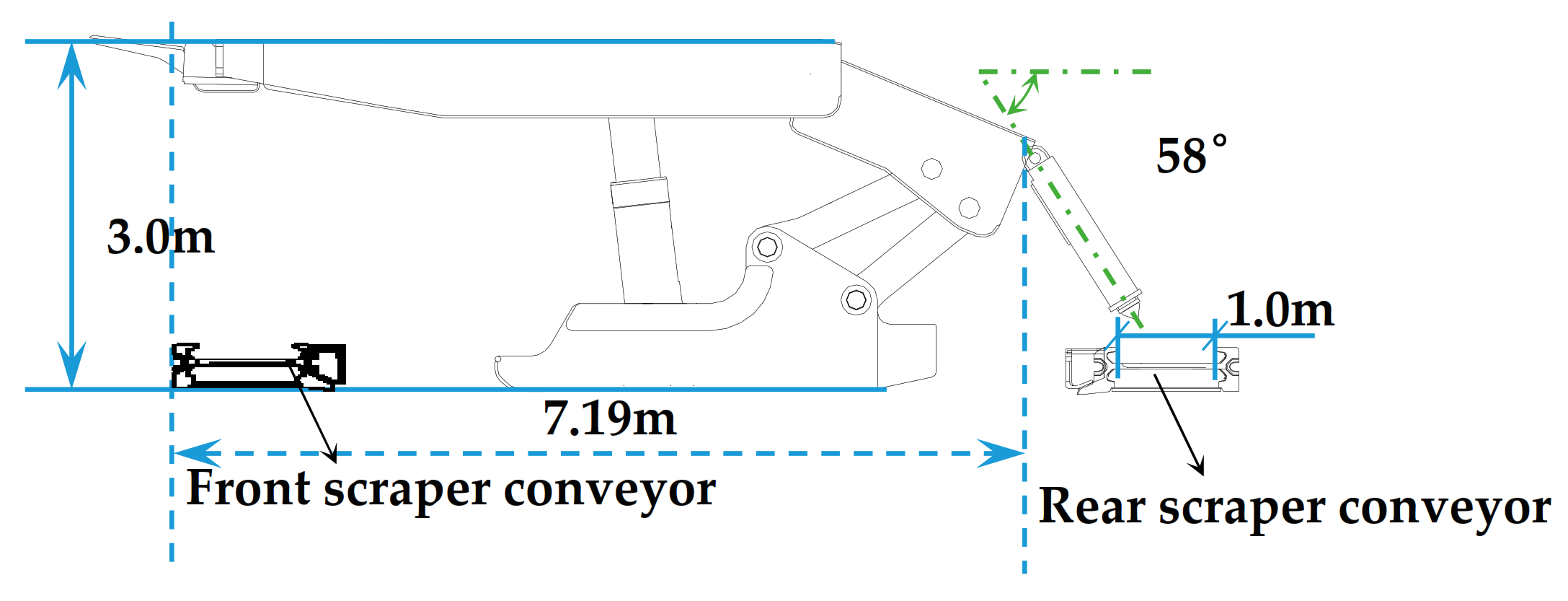

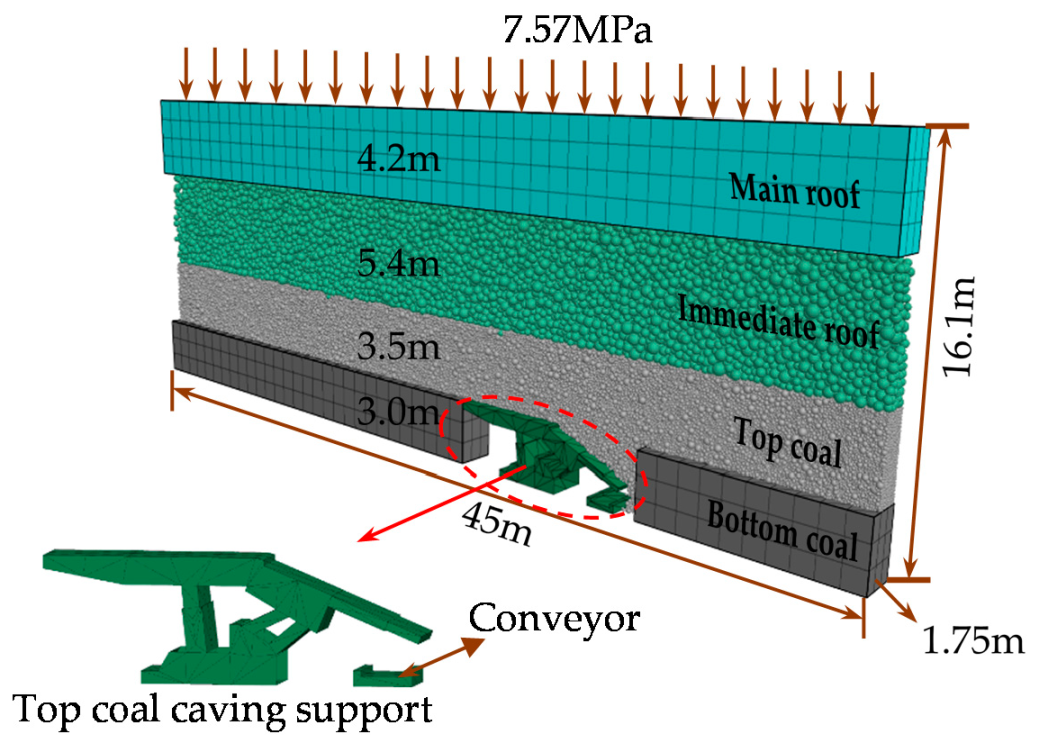


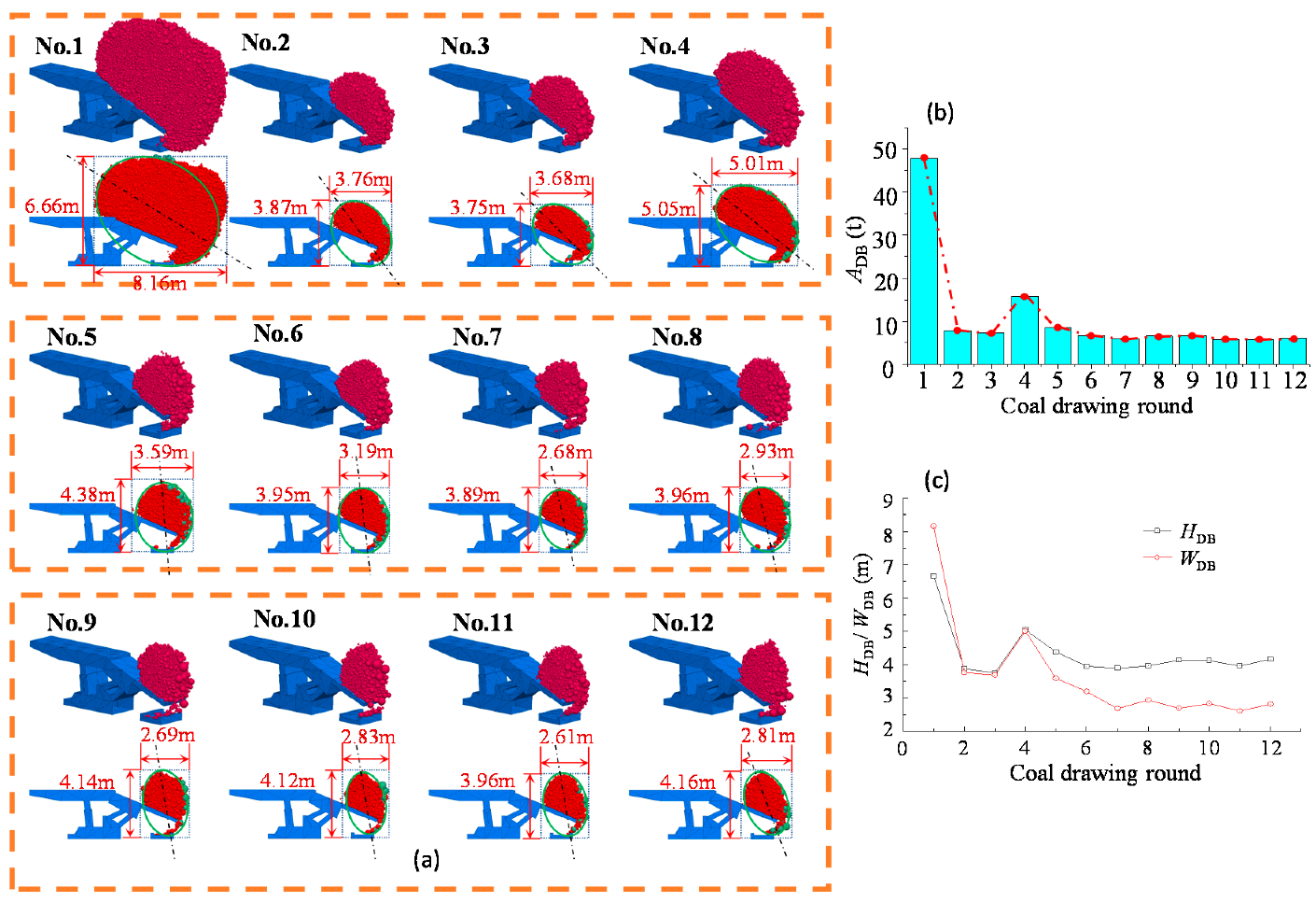
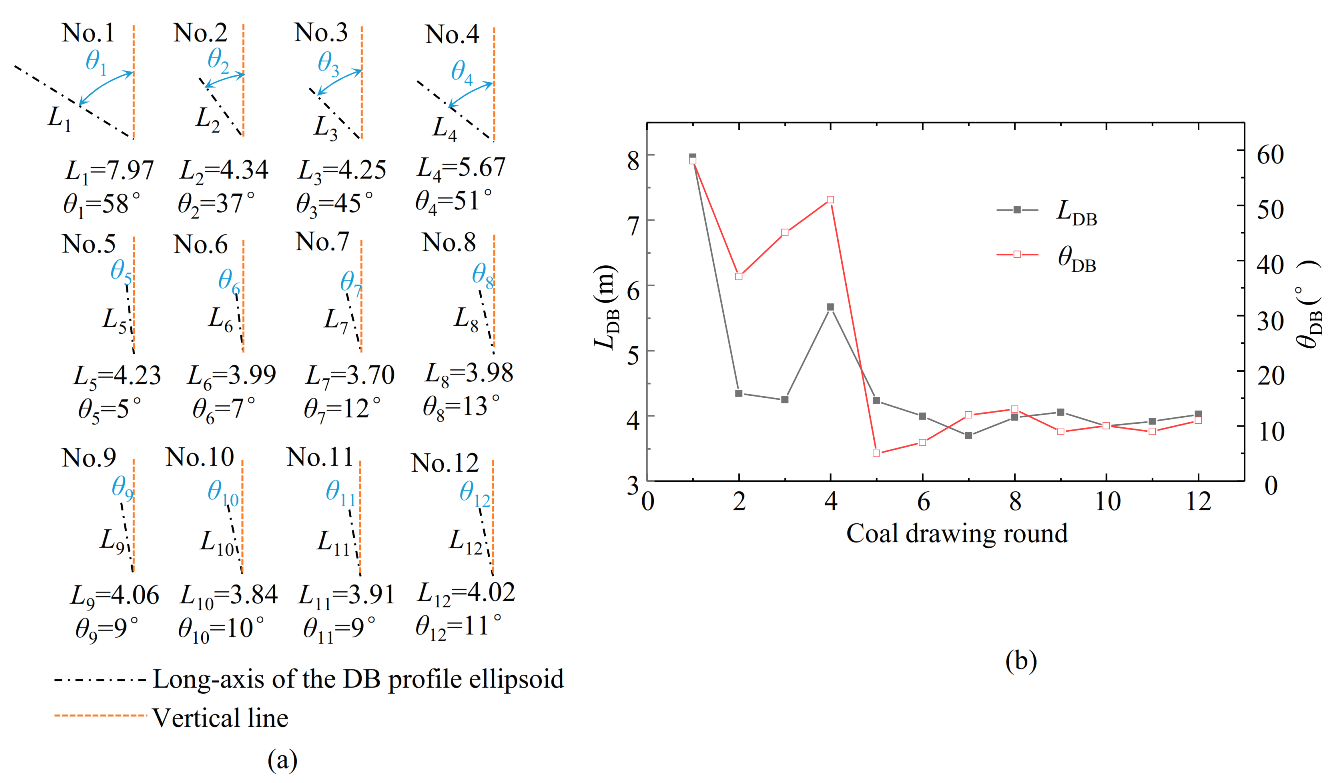
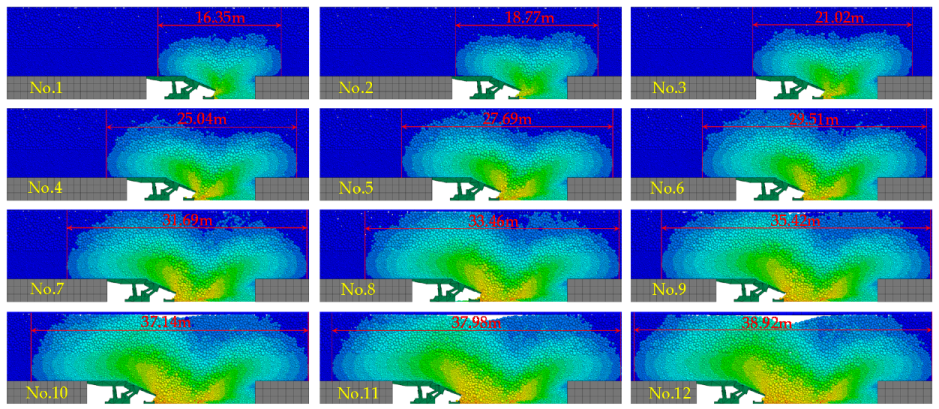
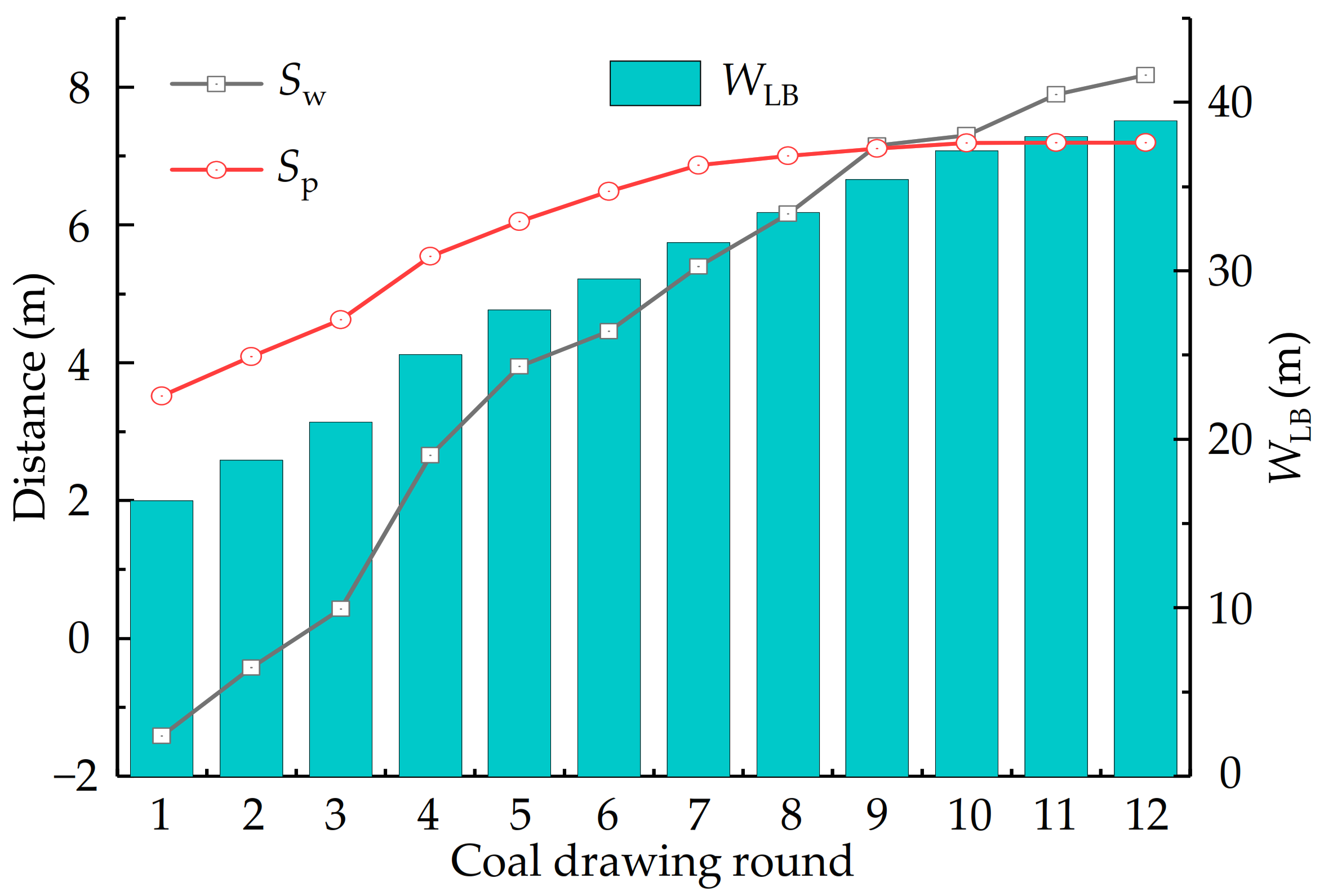
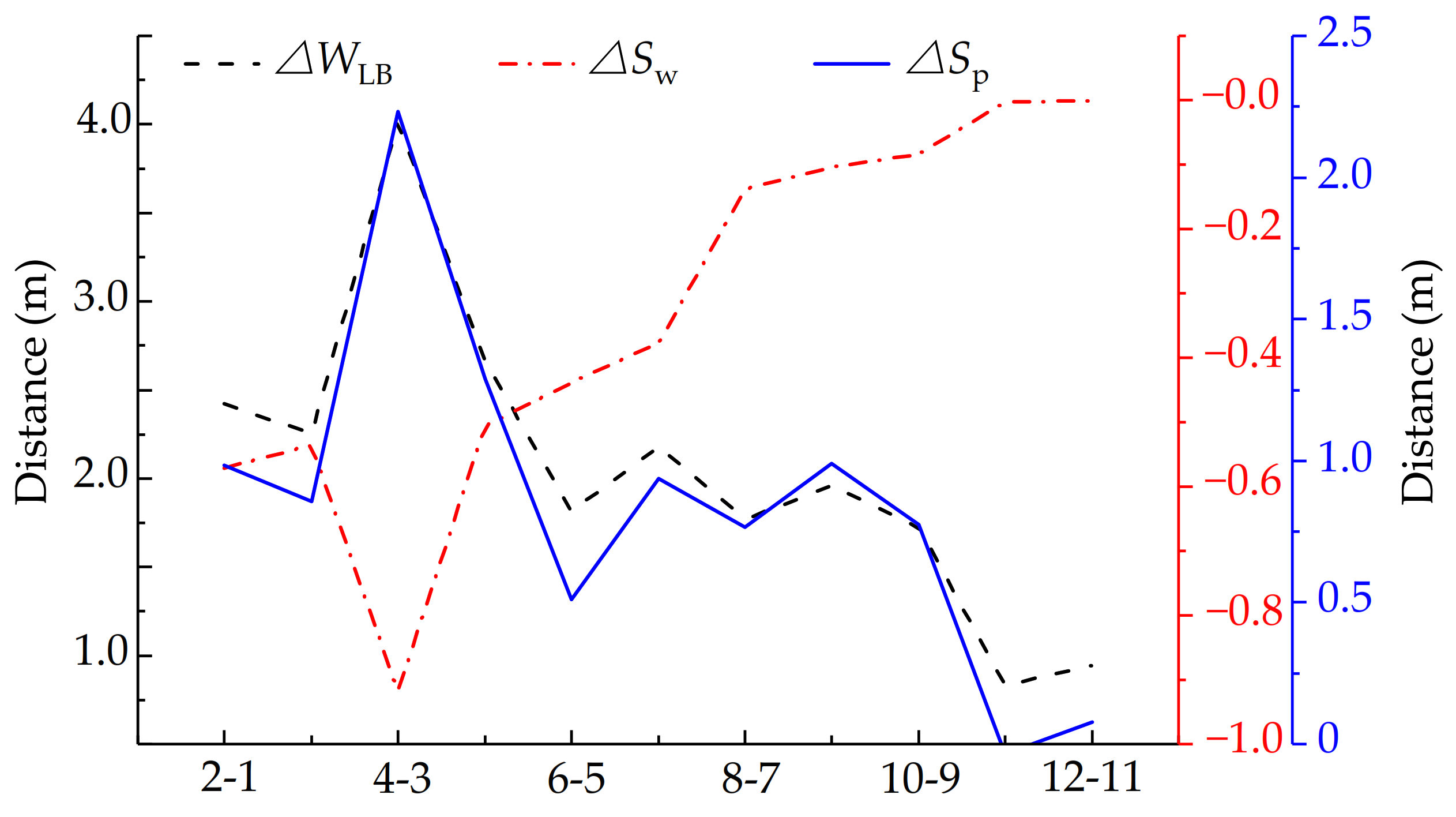
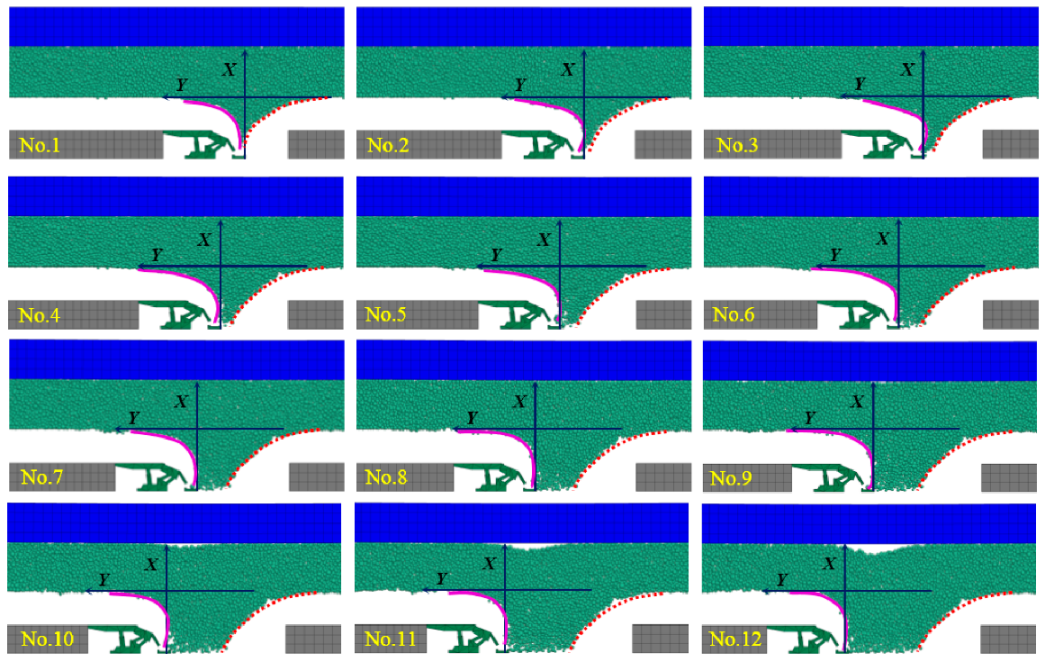

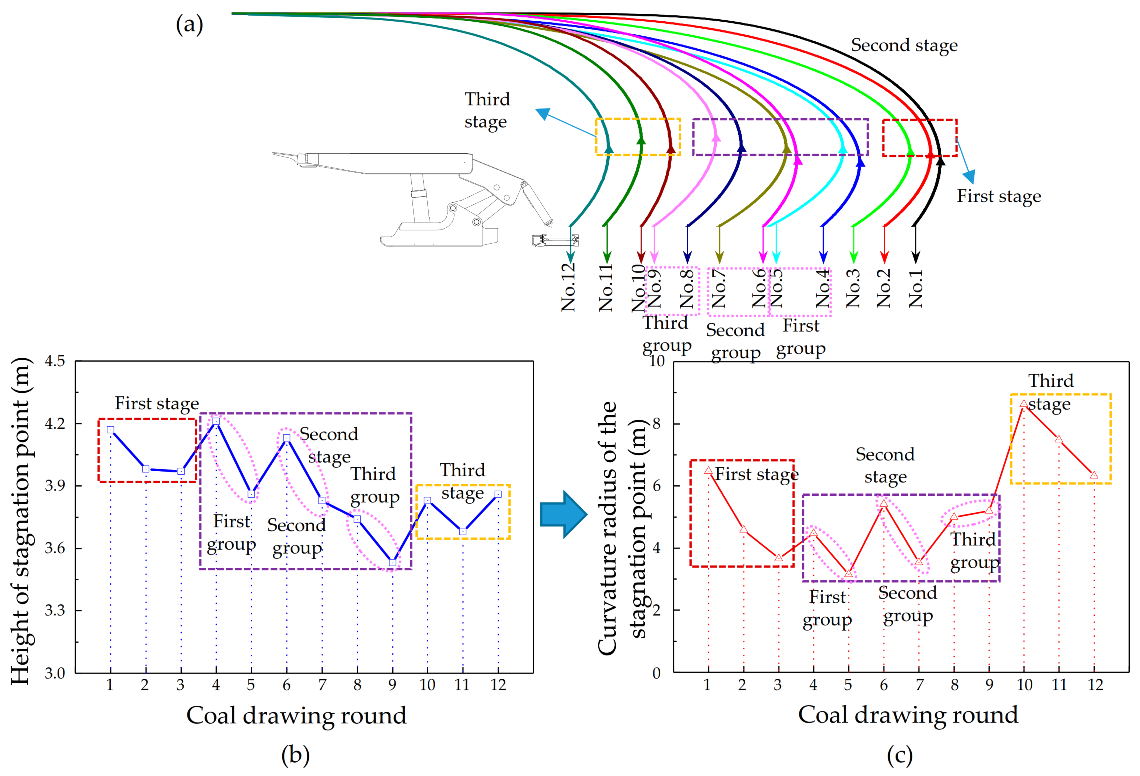
| Name | Thickness (m) | Lithology |
|---|---|---|
| Main roof | 4.2 | Fine sandstone |
| Immediate roof | 5.4 | siltstone |
| Top coal | 3.5 | coal |
| Bottom coal | 3.0 | |
| Floor | 1.6 | Fine sandstone |
| Diameter Range (cm) | Particle Mass Fraction (%) | |
|---|---|---|
| Top Coal | Immediate Roof | |
| 0–9 | 13.83 | \ |
| 9–18 | 46.31 | \ |
| 18–27 | 20.34 | \ |
| 27–36 | 19.52 | 13.83 |
| 36–45 | \ | 46.31 |
| 45–54 | \ | 20.34 |
| 54–63 | \ | 19.52 |
| Stratum Name | Unit Type | Constitutive Model | Young’s Modulus (GPa) | Density (kg/m3) | Poisson’s Ratio | Firc | dp Nratio | dp Sratio | kn (N/m) | ks (N/m) |
|---|---|---|---|---|---|---|---|---|---|---|
| Main roof | Zone | Elastic | 15.04 | 2660 | 0.35 | - | - | - | - | - |
| Immediate roof | Ball | Linear | 13.58 | 2650 | - | 0.5 | 0.3 | 0.3 | 4 × 108 | 4 × 108 |
| Top coal | Ball | Linear | 2.40 | 1390 | - | 0.5 | 0.3 | 0.3 | 2 × 108 | 2 × 108 |
| Bottom coal | Zone | Elastic | 2.40 | 1390 | 0.25 | - | - | - | - | - |
| Caving Step | Fitted Result | Stagnation Point Point Position | Radius of Curvature at the Stagnation Point |
|---|---|---|---|
| 1 | F1(x) = 0.157x2 + 0.123/x − 5.321x1/2 + 8.460 | 4.17 | 6.477 |
| 2 | F2(x) = 0.223x2 + 0.182/x − 7.046x1/2 + 10.225 | 3.98 | 4.579 |
| 3 | F3(x) = 0.274x2 + 0.025/x − 8.681x1/2 + 12.425 | 3.97 | 3.665 |
| 4 | F4(x) = 0.230x2 + 0.281/x − 7.899x1/2 + 12.051 | 4.21 | 4.467 |
| 5 | F5(x) = 0.319x2 + 0.042/x − 9.666x1/2 + 13.808 | 3.86 | 3.146 |
| 6 | F6(x) = 0.185x2 + 0.018/x − 6.207x1/2 + 9.455 | 4.13 | 5.417 |
| 7 | F7(x) = 0.283x2 + 0.022/x − 8.480x1/2 + 11.866 | 3.83 | 3.541 |
| 8 | F8(x) = 0.206x2 + 0.212/x − 5.894x1/2 + 8.273 | 3.74 | 4.996 |
| 9 | F9(x) = 0.202x2 + 0.284/x − 5.262x1/2 + 6.940 | 3.53 | 5.188 |
| 10 | F10(x) = 0.122x2 + 0.222/x − 3.604x1/2 + 5.238 | 3.83 | 8.629 |
| 11 | F11(x) = 0.141x2 + 0.236/x − 3.921x1/2 + 5.522 | 3.68 | 7.481 |
| 12 | F12(x) = 0.165x2 + 0.256/x − 4.942x1/2 + 7.203 | 3.86 | 6.322 |
Publisher’s Note: MDPI stays neutral with regard to jurisdictional claims in published maps and institutional affiliations. |
© 2021 by the authors. Licensee MDPI, Basel, Switzerland. This article is an open access article distributed under the terms and conditions of the Creative Commons Attribution (CC BY) license (http://creativecommons.org/licenses/by/4.0/).
Share and Cite
Huo, Y.; Zhu, D.; Wang, Z.; Song, X. Numerical Investigation of Top Coal Drawing Evolution in Longwall Top Coal Caving by the Coupled Finite Difference Method-Discrete Element Method. Energies 2021, 14, 219. https://doi.org/10.3390/en14010219
Huo Y, Zhu D, Wang Z, Song X. Numerical Investigation of Top Coal Drawing Evolution in Longwall Top Coal Caving by the Coupled Finite Difference Method-Discrete Element Method. Energies. 2021; 14(1):219. https://doi.org/10.3390/en14010219
Chicago/Turabian StyleHuo, Yuming, Defu Zhu, Zhonglun Wang, and Xuanmin Song. 2021. "Numerical Investigation of Top Coal Drawing Evolution in Longwall Top Coal Caving by the Coupled Finite Difference Method-Discrete Element Method" Energies 14, no. 1: 219. https://doi.org/10.3390/en14010219





